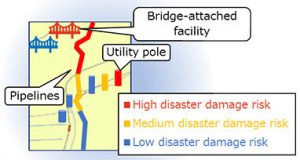
Resolution is as fine as individual telegraph poles.
“This technology allows for accurate disaster prediction by building a model that learns disaster patterns from facility data that the NTT Group has inspected and repaired [after] past disasters,” according to the company. “In addition, it can be predicted from publicly available data throughout Japan, making it possible to make predictions regardless of where the facility is installed.”
So far there are three algorithms:
With input data including rainfall, elevation, ground strength and distance from rivers, the company claims to be able to predict damage to an individual utility pole with 98% accuracy.
The figure is 90% for pipes attached to bridges during river flooding from data including water level fluctuation and river width, and, by knowing factors including what types of pipeline are buried in an area and the peak ground velocity of an earthquake, the number of damages/km of a pipeline can be predicted to 87% accuracy, it said.
Beyond this, it is proposing that similar AI be developed for the rest of Japan’s infrastructure, like power transmission lines and pipelines for water and gas.
Results will be exhibited at the Tsukuba Forum, 16 – 17 May this year